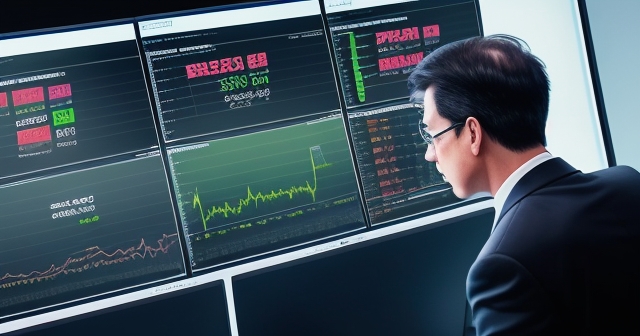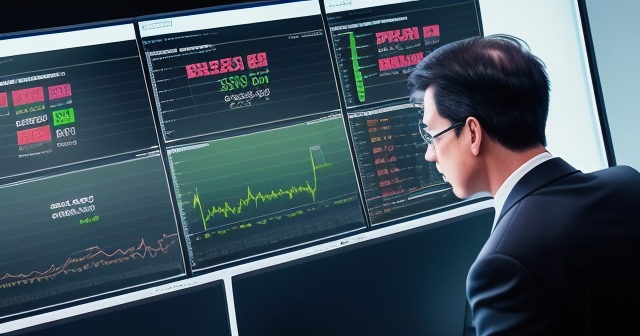Navigating the Currents: Understanding the S&P Regional Banks Select Industry Index and Sector Volatility
Welcome, aspiring investors and seasoned technical analysts. Today, we embark on a journey into a critical, yet often turbulent, segment of the U.S. financial landscape: the regional banking sector. You hear about banks in the news constantly, but what specifically happens with the mid-sized institutions that serve communities and businesses across the nation?
To truly grasp the dynamics of these vital institutions, we need a reliable compass. That’s where indices come in. They act as benchmarks, providing a pulse check on specific market segments. For U.S. regional banks, one of the most prominent and closely watched measures is the S&P Regional Banks Select Industry Index.
Why is this index so important? It’s not just a ticker symbol on a screen; it represents the collective health and performance of a group of institutions that play a significant role in the economy. By understanding this index, you gain insight into the fundamental forces shaping these banks’ fortunes and, consequently, potential investment opportunities or risks.
However, the story of regional banks isn’t always smooth sailing. Recent periods have highlighted significant challenges, from deposit instability to specific asset class exposures. Our goal today is to delve deep, combining the clarity of the index with a realistic look at the sector’s vulnerabilities, equipping you with the knowledge to navigate these complex waters.
Think of an index like a specialized weather report for a specific region. The S&P Regional Banks Index gives us the ‘weather’ for regional banks. But a good weather report also explains *why* it’s raining – perhaps a specific storm system is moving in. Similarly, we need to understand the underlying factors causing volatility in this sector.
Ready to unravel the complexities and gain a comprehensive understanding?
Key Takeaways:
- The S&P Regional Banks Select Industry Index serves as a critical benchmark for investors.
- Understanding sector vulnerabilities aids in making informed investment decisions.
- Policy discussions and macroeconomic factors heavily influence the regional banking sector.
| Term | Definition |
|---|---|
| S&P Regional Banks Select Industry Index | A benchmark measuring the performance of U.S. regional banks. |
| Regional Banks | Mid-sized banks serving specific geographic areas or a few states. |
| ETFs | Exchange Traded Funds that track the performance of specific indices. |
Defining the Benchmark: What is the S&P Regional Banks Select Industry Index?
Let’s start with the foundation. The S&P Regional Banks Select Industry Index, often referred to by its ticker SPSIRBK, is precisely what its name suggests: a focused measure of the performance of stocks within the U.S. regional banking sub-industry.
It belongs to the broader family of S&P Select Industry Indices, which are designed to provide granular exposure to specific, narrow sectors or industries based on the Global Industry Classification Standard, or GICS.
How are the constituents selected? S&P Dow Jones Indices methodology dictates that stocks included in this index are drawn from the S&P Total Market Index – a comprehensive benchmark representing virtually all publicly traded U.S. stocks. From this vast universe, only those companies classified under the GICS Regional Banks sub-industry make the cut.
This classification is crucial. It distinguishes regional banks from large national or international banks, investment banks, or other financial service providers. Generally, regional banks operate within a specific geographic area or a few contiguous states, though their size can still be substantial, often falling between community banks and the largest global financial institutions.
The index methodology specifies eligibility rules regarding market capitalization, liquidity, and domicile to ensure the constituents are tradable and representative. By focusing exclusively on the GICS Regional Banks sub-industry, the SPSIRBK provides a pure play on the performance of this distinct segment of the financial sector.
For investors and analysts, accessing official documentation like the index Factsheet and full Methodology is essential. These documents detail everything from the index’s calculation method (typically market-cap weighted, though specific rules may apply) to rebalancing schedules and constituent criteria. This level of detail ensures transparency and allows for accurate performance attribution and comparison.
Understanding the index’s construction is the first step. It tells us *what* we are measuring. Next, we need to look at *how* we can interact with this measure in the market.

Putting the Index to Work: Index-Linked Investment Products
Knowing about an index is valuable, but its real utility for investors often lies in the availability of products that track its performance. The S&P Regional Banks Select Industry Index is no exception.
The most popular way for many investors to gain exposure to the performance of U.S. regional banks is through Exchange Traded Funds (ETFs). These funds hold a portfolio of stocks designed to replicate the index’s composition and performance. The preeminent ETF tracking the SPSIRBK is the SPDR® S&P Regional Banking ETF, universally known by its ticker, KRE.
Think of KRE as a basket holding stocks of all the regional banks included in the SPSIRBK, weighted according to the index rules. When the index goes up, KRE typically goes up, and vice versa. This provides investors with a simple, diversified way to invest in the entire sector rather than picking individual bank stocks.
Besides KRE, other index-linked products exist, though they may serve different strategic purposes or target different markets:
- Leveraged ETFs: Products like the Direxion Daily Regional Banks Bull 3X ETF (DPST) offer magnified exposure to the index’s daily movements. Be aware that leveraged ETFs are complex and carry significant risks, often best suited for short-term trading strategies, not long-term investment.
- Futures: For more sophisticated traders, futures contracts based on the index, such as the E-mini S&P Regional Banks Select Industry Index futures (SXB) traded on CME Group, allow for hedging or speculating on the sector’s performance with leverage.
- International Listings: The index might be tracked by products listed on exchanges outside the U.S., catering to a global investor base.
Each of these products offers a different method of engaging with the S&P Regional Banks Index, appealing to varying risk appetites and trading strategies. For the average investor or analyst following the sector, the KRE ETF is typically the go-to proxy due to its liquidity and direct tracking of the benchmark.
Understanding that KRE is essentially a mirror of the SPSIRBK is key to interpreting its performance data, which is what we’ll look at next.

A Look at Recent Performance: What the Numbers Tell Us
Tracking the KRE ETF gives us a tangible picture of how the S&P Regional Banks Select Industry Index, and thus the underlying sector, has been performing. And in recent periods, the picture hasn’t always been rosy.
As of early-to-mid 2024, the regional banking sector has faced considerable headwinds. Looking at the performance metrics for the KRE ETF provides stark evidence of this stress. For example, as of April 16, 2024, commentary indicated the KRE ETF was down approximately 13% year-to-date. This represents a significant decline in a relatively short period, pointing to systemic concerns within the sector.
More recent data, like that available around July 5, 2024, shows some fluctuation but still highlights challenges. While the 1-year performance might show a positive return (e.g., 16.3% as of July 5, 2024), the year-to-date figure (e.g., -8.56% as of July 5, 2024) indicates that despite some recovery or volatility over twelve months, the start of the current year presented significant difficulties that weigh heavily on recent performance.
What does this underperformance signal? When a broad index covering an entire sector is down by double digits year-to-date, it suggests that issues are not isolated to just one or two companies. It implies that a significant portion of the index’s constituents – the individual regional banks – are experiencing difficulties.
Performance metrics like the Expense Ratio (the annual fee charged by the ETF) and Dividend Yield (the income generated by the underlying stocks) are also important characteristics of KRE to consider, but the raw price performance speaks most directly to the sector’s health and investor sentiment.
The recent price action in KRE serves as a market-driven indicator of the perceived risks and challenges facing regional banks. But what are these challenges, specifically? Let’s dig into the vulnerabilities that experts are highlighting.

Identifying Key Vulnerabilities: Why Experts Are Concerned
Market performance, as reflected in the KRE ETF, is a symptom. To understand the illness, we need to consult the experts and analyze the underlying structural weaknesses within the regional banking sector. Financial regulators and analysts have pointed to several critical areas of concern.
One prominent voice has been former FDIC Chair Sheila Bair. Her commentary, among others, highlights specific vulnerabilities that differentiate some regional banks from their larger, more diversified counterparts.
A significant concern is the concentration of certain types of assets or liabilities on regional banks’ balance sheets. We often hear about two specific areas:
- Commercial Real Estate (CRE) Exposure: Many regional banks have substantial loan portfolios tied to commercial properties – offices, retail spaces, etc. With shifts in work patterns and economic uncertainty, the value and repayment prospects of these loans are under scrutiny. A downturn in the CRE market could lead to significant losses for banks heavily exposed to this sector.
- Reliance on Industry Deposits: Unlike large banks with vast, diversified deposit bases from millions of individuals, some regional banks rely more heavily on deposits from specific industries or large corporate clients. These deposits can be less stable and more prone to rapid withdrawal, especially in times of stress.
These concentrations are like having too many eggs in one basket. If that basket tips, the impact is much greater.
However, perhaps the most widely discussed and critical vulnerability is the structure of bank deposits themselves, particularly the issue of uninsured deposits.
Deposits up to a certain limit ($250,000 per depositor, per insured bank, for each account ownership category) are insured by the FDIC. But deposits exceeding this limit are uninsured. While uninsured deposits are present at all banks, some regional banks may have a higher proportion of these potentially volatile funds, especially from businesses and wealthy individuals.
The fear, as highlighted by experts like Sheila Bair, is the potential for rapid withdrawal of these uninsured deposits – a classic “bank run” – triggered by a loss of confidence. And what could trigger such a loss of confidence? Another bank failure.
The collapse of a single institution, particularly if it involves similar risk factors present elsewhere in the sector, can create a contagion effect, prompting depositors at other, seemingly healthy, regional banks to withdraw their funds preemptively. This risk creates a delicate situation where stability is fragile and heavily dependent on market sentiment and perceived safety.
Understanding these interconnected risks – CRE exposure, industry deposit reliance, and the instability of uninsured deposits – is fundamental to analyzing the recent performance of the S&P Regional Banks Select Industry Index and its constituents.
| Vulnerability | Description |
|---|---|
| Commercial Real Estate Exposure | Risk associated with loans tied to commercial properties which may decline in value. |
| Reliance on Industry Deposits | Dependence on large clients, making deposits less stable during economic stress. |
| Uninsured Deposits | Higher proportion of deposits exceeding FDIC insurance limits, increasing withdrawal risk. |
Case Study: New York Community Bancorp (NYCB) in the Spotlight
To make these abstract risks more concrete, let’s look at a specific example from the S&P Regional Banks Select Industry Index itself. The situation involving New York Community Bancorp (NYCB) provides a clear illustration of how these sector vulnerabilities can manifest in a single institution, sending ripple effects through the market and impacting the index.
NYCB’s stock experienced a dramatic decline in early 2024, plunging over 70% year-to-date by April 2024. What caused this severe reaction?
The immediate catalyst was the bank reporting unexpected heavy losses and, crucially, identifying material weakness in its internal controls. This admission of internal control issues struck a nerve, raising questions about the bank’s ability to manage risk effectively.
Adding complexity to NYCB’s situation was its acquisition of assets from the failed Signature Bank in 2023. While this acquisition expanded NYCB’s footprint, it also potentially absorbed some of Signature Bank’s challenges or created new integration risks. Furthermore, the acquisition pushed NYCB over a critical asset threshold, subjecting it to stricter regulatory oversight, which may have highlighted existing issues or imposed new requirements.
NYCB’s troubles resonated across the sector for several reasons:
- It highlighted the potential for unexpected losses, including those tied to legacy assets or changing economic conditions.
- The mention of internal control weaknesses fueled concerns about risk management practices at other regional banks.
- Most significantly, it rekindled anxieties about deposit stability, particularly the behavior of uninsured deposits, and the potential for contagion if another institution faced similar stress.
The severe stock price drop in NYCB was not an isolated event in terms of sector sentiment. Other regional banks, even those without specific NYCB-like catalysts, saw their share prices pressured as investors reassessed the risks across the board. While NYCB’s situation was particularly acute, the market reaction demonstrated the interconnectedness and fragility within the sector tracked by the S&P Regional Banks Select Industry Index.
This case study underscores why tracking the performance of individual constituents is just as important as watching the aggregate index like KRE. The health of the parts directly impacts the health of the whole.

Policy Responses and the Call for Stability
Given the sector’s vulnerabilities and the potential for contagion, policy discussions around stabilizing regional banks have become increasingly prominent. Experts and former regulators have voiced opinions on potential actions to shore up confidence and prevent future crises.
A key area of debate has centered on the issue of deposit insurance and the stability of uninsured deposits. As Sheila Bair and others have pointed out, the large pools of uninsured funds held by businesses can be highly mobile, posing a significant risk during times of stress.
One specific policy recommendation that has gained traction is the reinstatement of the FDIC’s transaction account guarantee authority. This temporary authority, used during the 2008 financial crisis, allowed the FDIC to fully guarantee all funds in non-interest-bearing transaction accounts (primarily business checking accounts), regardless of the amount, for a limited time.
Advocates argue that bringing back this authority, perhaps even on a standby basis that could be activated quickly, would provide a critical backstop against deposit flight. Knowing that all business deposits are guaranteed, even those exceeding the $250,000 limit, could prevent panic withdrawals from otherwise healthy regional banks if another institution fails.
This is essentially like providing a sturdy safety net *before* someone falls. It aims to preempt the trigger event (a bank failure) from spiraling into a wider crisis for the sector.
The decision to implement such a policy rests with policymakers, including Congress and banking regulators. It involves weighing the benefits of enhanced stability against potential costs, such as moral hazard (where banks might take on more risk knowing deposits are fully guaranteed) or the perceived fairness to uninsured depositors at other types of institutions.
The debate around deposit guarantees is just one facet of the broader policy landscape affecting regional banks. Regulatory changes, capital requirements, and supervisory practices all play a role in shaping the operating environment and resilience of these institutions. Staying informed about these policy discussions is crucial for understanding the potential future trajectory of the sector and its impact on the S&P Regional Banks Select Industry Index.

Macroeconomic Headwinds and Tailwinds
No financial sector operates in a vacuum, and regional banks are particularly sensitive to the broader macroeconomic environment. The performance of the S&P Regional Banks Select Industry Index is heavily influenced by factors far beyond the individual operations of its constituent banks.
Key macroeconomic forces at play include:
- Interest Rates: Set by the Federal Reserve (Fed), interest rates are perhaps the most significant driver of bank profitability. Banks make money on the spread between what they earn on assets (like loans) and what they pay on liabilities (like deposits). Changes in the Fed’s policy rate directly impact both sides of this equation. Rising rates can increase net interest margins initially, but they can also pressure loan demand and potentially lead to losses on existing lower-rate assets. Falling rates have the opposite effect.
- Inflation: High inflation can influence Fed policy on interest rates and also impact the cost of doing business for banks and the financial health of their borrowers. Persistent inflation can erode purchasing power, affecting loan repayment capacity.
- Jobs Reports (e.g., Non-Farm Payrolls – NFP): The strength of the labor market is a key indicator of economic health. A robust jobs report suggests consumers and businesses are earning income, making them more likely to repay loans and potentially demand new credit. A weakening job market signals potential stress for borrowers.
- Overall Economic Growth: The general pace of economic activity affects loan demand, credit quality, and deposit growth for regional banks. A strong economy provides tailwinds, while a recession creates significant headwinds.
- Market Sentiment: Broader market movements, reflected in indices like the S&P 500, Dow Jones Industrials Index, and Nasdaq 100 Index, often spill over into the banking sector. General risk-on or risk-off sentiment can impact bank stock valuations regardless of specific fundamentals.
For instance, ongoing concerns about inflation may keep the Fed from cutting interest rates quickly, potentially continuing to pressure certain parts of bank balance sheets while supporting others. Conversely, a strong jobs report might signal economic resilience, which is generally positive for loan portfolios.
Analyzing the S&P Regional Banks Select Industry Index solely based on bank-specific news is insufficient. We must always consider the prevailing macroeconomic climate and the forward-looking expectations about variables like interest rates and economic growth. These external forces provide the context within which the sector’s internal strengths and weaknesses play out.
The Evolving Landscape: Shifting Dynamics in Banking
Beyond the traditional risks and macroeconomic factors, the U.S. banking landscape is constantly evolving. Changes in technology, consumer behavior, and competition are also shaping the future for the institutions represented in the S&P Regional Banks Select Industry Index.
One interesting trend highlighted by recent data, such as commentary citing PYMNTS Intelligence, is a reported shift in consumer behavior. While the largest banks and regional banks have historically dominated many areas, there seems to be an increasing use of smaller community banks and credit unions for specific financial products, such as credit cards.
What does this mean for the regional banks we are discussing? This trend suggests evolving competitive dynamics. Community banks and credit unions often have deep local ties and may offer different service models or fee structures that appeal to specific customer segments. If regional banks face increased competition from these smaller institutions, it could impact their market share, deposit gathering capabilities, and profitability in certain product lines.
Furthermore, the rise of financial technology (FinTech) companies is challenging traditional banking models across the board. Digital payment systems, online lending platforms, and neobanks are all competing for pieces of the financial services pie. While regional banks are investing in technology, adapting to this rapidly changing digital environment is a continuous challenge.
These shifts mean that assessing a regional bank‘s prospects isn’t just about looking at its balance sheet or loan portfolio in isolation. It also requires evaluating its ability to innovate, compete effectively in a crowded marketplace, and adapt to changing customer preferences.
For investors using the S&P Regional Banks Select Industry Index as a guide, these evolving dynamics serve as a reminder that the fundamental business model of banking is not static. Keeping an eye on these longer-term trends is crucial for a complete understanding of the sector’s future potential.
Analyzing with a Technical Lens: Applying Technical Analysis to the Index
While understanding the fundamental drivers of the regional banking sector is essential (that’s the EEAT aspect – expertise, authority, trustworthiness), many traders also rely on technical analysis to inform their decisions regarding assets like the KRE ETF.
Technical analysis involves studying past price movements and trading volume to identify patterns and predict future price action. For a highly liquid ETF like KRE, technical analysis tools can be quite applicable.
How might a technical analyst look at KRE?
- Price Charts: Analyzing candlestick or bar charts over various timeframes (daily, weekly, monthly) to identify trends, support and resistance levels, and chart patterns (e.g., head and shoulders, flags, pennants). For example, a significant decline in KRE might be analyzed to find potential support levels where buying interest could emerge.
- Moving Averages: Using moving averages (e.g., 50-day, 200-day) to smooth out price data and identify the direction of the trend. A death cross (50-day moving average crossing below the 200-day moving average) on KRE’s chart, for instance, is often seen as a bearish signal.
- Oscillators and Indicators: Employing tools like the Relative Strength Index (RSI), MACD, or Stochastic Oscillator to gauge momentum, identify overbought or oversold conditions, and spot potential trend reversals. A low RSI reading on KRE might suggest the recent sell-off is exhausted, potentially preceding a bounce.
- Volume Analysis: Examining trading volume alongside price action. Increased volume during a price decline in KRE could suggest strong selling pressure, while increasing volume during a rally might indicate conviction among buyers.
Technical analysis provides a different perspective than fundamental analysis. While fundamental analysis asks “Is this sector healthy and undervalued?”, technical analysis asks “What is the market *doing* right now, and where is it likely to go based on its behavior?”.
For traders specifically interested in the regional banking sector, applying technical analysis to the KRE ETF can help time entry and exit points, set stop-loss orders, and manage risk based on price volatility and patterns. However, it’s important to remember that technical analysis is not foolproof and should ideally be used in conjunction with an understanding of the fundamental and macroeconomic factors discussed earlier.
Combining the “why” (fundamentals) with the “when” (technical analysis) can lead to more informed trading decisions. But this requires not just knowledge of the tools, but also a reliable platform to use them effectively.
Putting It All Together: Implications for Investors and Traders
So, we’ve explored the S&P Regional Banks Select Industry Index, its tracking tools like the KRE ETF, the specific risks facing the sector (CRE, uninsured deposits, etc.), policy responses, macroeconomic influences, evolving competitive dynamics, and how technical analysis can be applied.
What does this comprehensive picture mean for you, whether you’re a new investor building a portfolio or an experienced trader looking for opportunities?
For investors:
- The S&P Regional Banks Select Industry Index provides a clear segment to track if you want exposure specifically to mid-sized U.S. banks.
- The recent performance of KRE signals that the sector is currently facing significant challenges and uncertainty. This isn’t a sector to invest in blindly.
- Understanding the fundamental risks, particularly related to CRE and uninsured deposits, is critical for assessing the long-term viability and stability of the sector and its individual constituents.
- Policy decisions regarding deposit insurance and regulation could have a material impact on the sector’s risk profile.
- Macroeconomic factors like interest rates and economic growth will continue to be major determinants of performance.
For traders:
- The volatility seen in KRE can present trading opportunities for those comfortable with higher risk.
- Technical analysis tools can help identify short-term trends, support/resistance levels, and potential entry/exit points for trading the ETF or related futures (SXB).
- Staying informed about news related to specific bank failures (like NYCB‘s situation) or policy announcements is crucial, as these can cause rapid price movements that impact index-linked products.
- Leveraged products like DPST amplify both potential gains and losses and require careful risk management.
Whether your approach is fundamental or technical, understanding the nuances of the S&P Regional Banks Select Industry Index and the sector it represents is vital. It’s a segment of the market exposed to unique risks and heavily influenced by external factors. It requires careful analysis, constant monitoring, and a healthy respect for the potential for volatility.
We’ve covered a lot of ground, moving from the definition of an index to the nitty-gritty of sector risks and trading approaches. Does it feel like you have a better grasp of this complex area now?
Conclusion: Measuring Risk and Opportunity in Regional Banking
In conclusion, the S&P Regional Banks Select Industry Index stands as an indispensable tool for measuring the pulse of the U.S. regional banking sector. Through instruments like the SPDR® S&P Regional Banking ETF (KRE), investors and traders gain access to this vital part of the financial institutions landscape.
However, simply tracking the index is not enough. As we have seen, the sector faces material and interconnected vulnerabilities, most notably tied to Commercial Real Estate (CRE) exposure and the potential instability stemming from uninsured deposits. Expert commentary, such as that from former FDIC Chair Sheila Bair, underscores the seriousness of these issues and the potential for events like a bank failure to trigger broader stress.
The recent performance of the KRE ETF and the specific challenges faced by constituents like New York Community Bancorp (NYCB) serve as real-world examples of these risks materializing. These events not only impact individual stocks but also weigh on the overall index performance, reminding us that the aggregate measure is a reflection of the health of its underlying components.
Policy responses, including discussions around reinstating the FDIC’s transaction account guarantee authority, are crucial elements in the ongoing effort to enhance sector stability and manage the risk of deposit flight. These regulatory considerations, coupled with the pervasive influence of macroeconomic factors like interest rates and inflation, create a complex environment that requires diligent analysis.
Furthermore, the evolving competitive landscape, marked by shifts in consumer behavior and the rise of FinTech, adds another layer of complexity to the future outlook for regional banks.
For you, whether you are approaching this sector from an investment or trading perspective, a thorough understanding of both the quantitative measures (the index, performance data) and the qualitative risks (CRE, uninsured deposits, policy) is paramount. Technical analysis can aid in timing, but it should be informed by this foundational knowledge.
The S&P Regional Banks Select Industry Index is more than just a number; it’s a gateway to understanding a critical part of the economy currently navigating significant challenges. By combining knowledge of the index with a deep dive into the sector’s fundamentals and risks, you position yourself to make more informed decisions in this dynamic and sometimes turbulent market segment.
s&p regional banksFAQ
Q:What is the S&P Regional Banks Select Industry Index?
A:It is a benchmark that measures the performance of U.S. regional banking stocks.
Q:What are the main risks facing regional banks?
A:Key risks include commercial real estate exposure, reliance on industry deposits, and higher levels of uninsured deposits.
Q:How can investors gain exposure to the regional banking sector?
A:Investors can use products such as the SPDR® S&P Regional Banking ETF (KRE) or leveraged ETFs to gain exposure to this sector.

留言